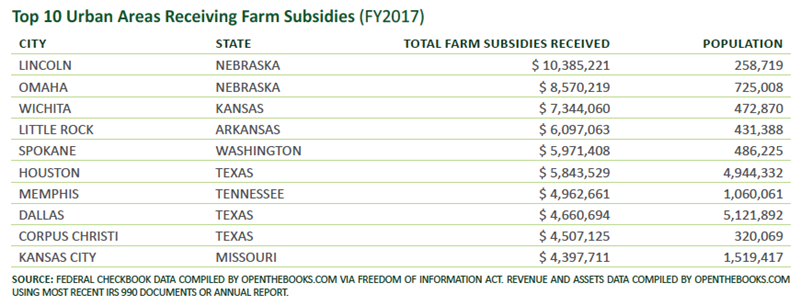-
The federal government awarded $13.2 billion in farm subsidies to 957,109 recipients in FY2017.
-
389 recipients received $1 million or more in FY2017 farm subsidies. These top recipients ranged from Pinicon Farms in Iowa ($9.9 million) to Pushen and Pullen Farm in Missouri ($1 million). See the Appendix for the full list of $1 million farm subsidy recipients.
-
$626 million in farm subsidies flowed to urban areas with populations of 250,000 or more (FY2015-FY2017).

-
Nearly one quarter of all FY2017 farm subsidies ($3 billion) went to just 5,952 recipients who received $250,000 or more each. The top recipients included Pinicon Farms in Iowa ($9.9 million); Heard Family Farm in Georgia ($8.9 million); and Hader Farms Partnership in Minnesota ($8.7 million).
-
America’s five most populated cities received $17 million, collectively, in farm subsidies – Chicago ($7.7 million); Miami ($4.5 million); New York City ($2.8 million); Los Angeles ($1.6 million); and Philadelphia ($309,000) – during a three-year period (FY2015-FY2017).
-
In FY2017, $4.8 million in farm subsidies flowed to the upper-middle class elites in America’s 150 most expensive zip codes. These zip codes included Beverly Hills, California, 90210 ($15,488); New York City, New York, 10022 ($83,169); and Hawaii County, Hawaii, 96750 ($230,697). Affluent cities such as Aspen, Colorado ($278,000); Palm Springs, California ($310,420); and Park City, Utah ($1.8 million) reaped large amounts of subsidies.
-
Paid not to farm – $1.8 billion in Conservation Reserve Program (CRP) payments flowed to farmers in FY2017. Farmers received these rental payments in exchange for not using their land. The contracts can last between 10 and 15 years.
-
The state of Iowa received nearly nine percent ($1.1 billion) of all farm subsidies in FY2017. The top 10 states, including Iowa, received 59 percent ($7.8 billion) of all farm subsidies.
-
In FY2017, 58 percent ($7.7 billion) of farm subsidies flowed directly to individuals. The remaining 42 percent was distributed to 15 other categories including general partnerships, corporations, Indian tribal ventures, churches, and more.
-
More than 78 percent of all farm subsidies flowed through three farm subsidy programs: agricultural risk coverage ($3.8 billion); marketing assistance loan ($3.5 billion); and price loss coverage ($3.2 billion). Agricultural risk coverage and price loss coverage both protect farmers against adverse changes in market conditions. Marketing assistance loans assist farmers when market prices are low, allowing them to hold on to commodities instead of selling them immediately.